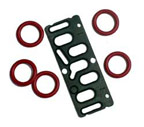Some
of the most common materials used for oil seals are nitrile,
highly saturated nitrile, Viton®, FEP, silicone and polyacrylate.
| Materials
& Temperature |
Applications
|
Use
With These Fluids |
Simriz®
-10
C to +305 C Compound Specific
|
Simriz®
oil seals are molded of an elastomer that has the broadest chemical
resistance of any elastomeric material. They combine all the
resilience and sealing force of an elastomer with a chemical
resistance approaching that of FEP. |
most
chemicals |
Aflas®
-10 C to +204 C Compound Specific
|
Aflas®
oil seals are made from a unique fluoroelastomer that is resistant
to petroleum oils, steam, hydrogen sulfide and amine corrosion
inhibitors. |
petroleum
oils, H2S, steam |
Carboxilated
Nitrile
-54°C to 135°C |
Nitrile
oil seals are made from a compound that tolerates low temperatures
and has excellent abrasion resistance. |
petroleum
oils, water |
FKM Fluorocarbon
-40 C to +204 C Compound Specific |
FKM Fluorocarbon
oil seals feature excellent resistance to petroleum products
and solvents. They have good high temperature and low compression
set characteristics. They are suited for use with wide chemical
exposure situations and for hard vacuum service. |
petroleum
oils, gasoline, transmission fluid |
Fluorosilicone
-56°C to 204°C |
A
fluorosilicone oil seal combines the good high and low temperature
stability of silicone with the fuel, oil, and solvent resistance
of fluorocarbon. This oil seal is resistant to petroleum oils
and gasoline. |
petroleum
oils, gasoline |
Highly
Saturated Nitrile (HSN, HNBR)
-26°C to 160°C |
Oil
seals made from highly saturated nitrile have excellent resistance
to petroleum oils and sour gas. Because of the extended temperature
range of highly saturated nitrile, it is becoming a preferred
compound in the oil patch. |
petroleum
oils, H2S, CO2 |
Nitrile
(Buna-N)
-40°C to 135°C
Nitrile (Low-Temp)
-65°C to 120°C |
Nitrile
is presently the seal industry's most widely used elastomer.
Nitrile oil seals combine excellent resistance to petroleum
based oils and fuels, silicone greases, hydraulic fluids,
water and alcohols. Nitrile has a good balance of working
properties such as low compression set, high tensile strength,
high abrasion resistance, combined with a low cost. |
petroleum
oils,
water, hydraulic oils |
Polyurethane
-40°C to 105°C |
Polyurethane
is an excellent material with high abrasion resistance characteristics
and high tensile strength. Polyurethane oil seals are used
in high pressure hydraulic systems where highly stressed parts
are subject to wear. These seals are resistant to petroleum
oils and hydraulic oils. |
petroleum
oils,
hydraulic oils |
FEP
-20°C to 204°C |
FEP
is a tough, chemically inert polymer possessing an incredible
working range. Oil seals from this material are for static
and slow intermittent dynamic situations. FEP is hampered
by a poor memory at low temperature. |
most
chemicals |
Polyacrylate
-20°C to 170°C |
Polyacrylate
has better heat resistance than Nitrile. It works well in
high surface speed oil seals. |
petroleum
oils, Freon |
Silicone
-60°C to 200°C |
Silicone
oil seals have a high lubricant absorbency which minimizes
friction and wear. |
petroleum
oils, some acids |


